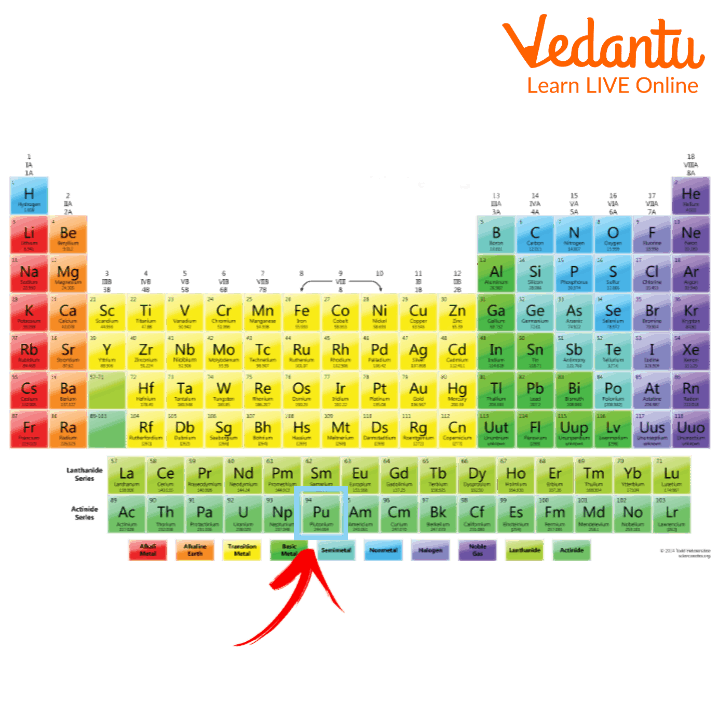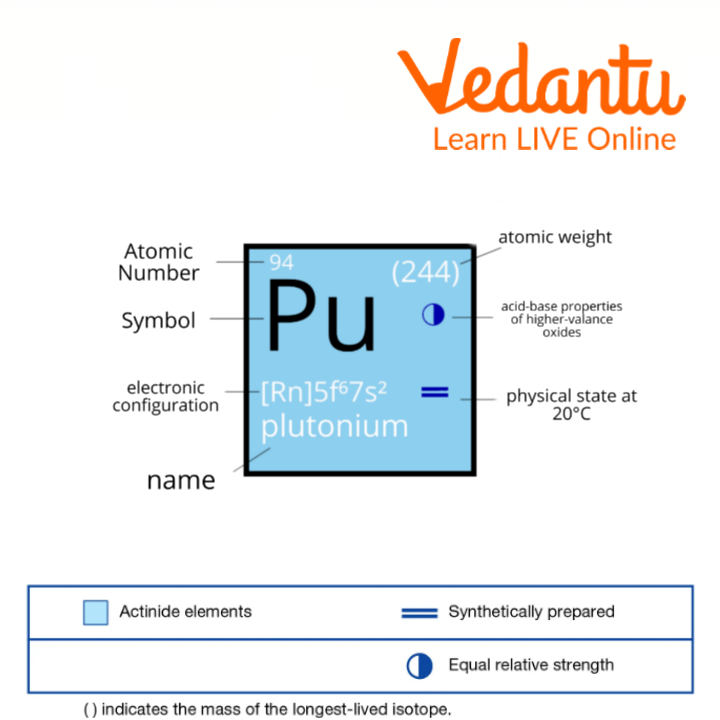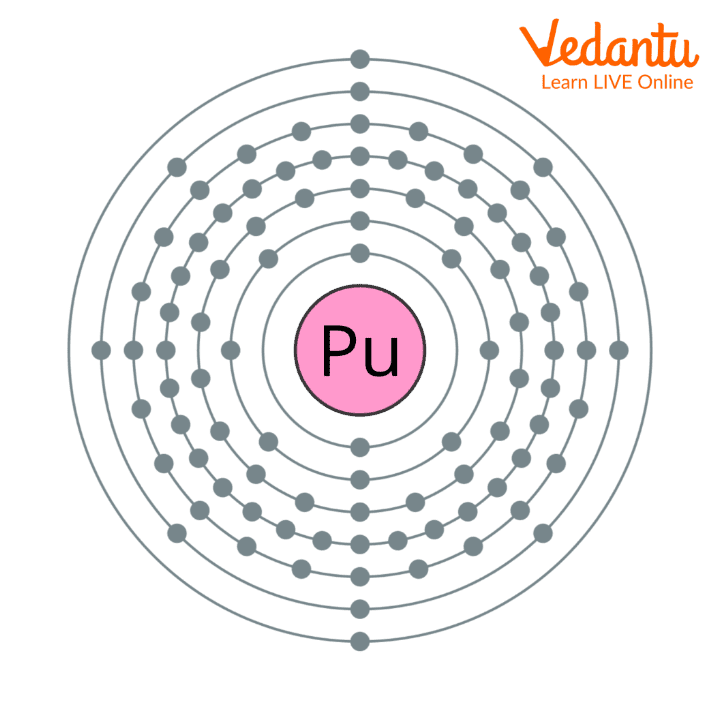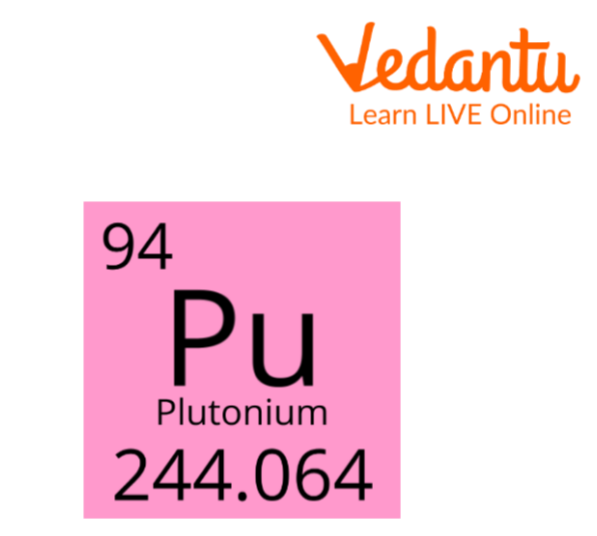




Interesting Plutonium Facts
Plutonium is the 94th element in the periodic table, it is a radioactive element and is majorly synthetically made. Although scientists have discovered small amounts of naturally occurring plutonium created under incredibly rare geological conditions, plutonium is still regarded as a man-made material. It is mainly used in the nuclear industry like making nuclear weapons like atomic bombs because of its radioactivity. In this article we will state some interesting facts about this element and also talk about its symbol, electronic configuration, structure and later state some of its uses in today’s industries.
Plutonium on the Periodic Table
Plutonium (Pu), atomic number 94 in the actinide family of the periodic table, is a radioactive chemical element. Due to its employment as nuclear reactor fuel and a component of nuclear weapons, it is the most significant transuranium element.

Plutonium on Periodic Table
Characteristics of Plutonium
With an atomic number of 94, plutonium is the second transuranic element and a member of the actinide group on the periodic table.
Like neptunium, which was named after the planet Neptune, Plutonium is named after the planet Pluto. It is an actinide metal that seems silvery-grey; yet, when exposed to oxygen, it develops a dull covering.
There are six different allotropes and four oxidation states of this element. With nitrogen and hydrogen, it reacts.
When the metal is present in high concentrations, alpha decay causes the metal to warm up to the point where water can boil.
Plutonium is primarily produced by irradiating uranium in nuclear reactors, with uranium serving as the principal source of this element. Typically, nature does not contain plutonium.
Name: Plutonium
Symbol of Plutonium: Pu
Atomic Number: 94
Atomic Mass: (244.0) amu
Number of Protons/Electrons: 94

Plutonium characteristics
Specifications of Plutonium
With the majority of metals, plutonium forms intermediate compounds and alloys.
Plutonium and other transuranium elements like Neptunium, Americium, and Curium pose a radioactive risk and should be treated with caution.
At normal temperature, plutonium has a very high resistance. Even at low temperatures, it is high.
When melted, plutonium increases its density by 2.5%; however, when compared to other metals, it has a relatively high surface tension and viscosity.
Uses of Plutonium
Due to its radioactive nature, plutonium isn't particularly useful in any application.
The use of this element as an energy source is one of its primary uses. The early atomic bombs included it.
The element is employed in nuclear weapons because it is a crucial fissile component, is more readily available, and fissions more easily than other elements.
Plutonium-239, one of its isotopes, is a component of modern nuclear bombs.

Plutonium-238 Used in NASA
Facts About Plutonium
Plutonium Element: It is an element which belongs to group 20 and period 7 in the periodic table.
Plutonium Electrons: Plutonium has in total 94 electrons.
Plutonium Atomic Structure:

Plutonium Atomic Structure
Plutonium Symbol:

Plutonium Symbol.
A silver metal with radioactivity, plutonium may be employed for both creation and destruction. Even though it was once employed for destruction, today the element is mostly used for energy creation all over the world.
In nature, plutonium is seldom encountered. Naturally occurring uranium ores include trace amounts of plutonium.
Sample Questions
1. What is plutonium's electronic configuration?
Ans: Pu- atomic number : 94
Electrical configuration: 1s2 2s2 2p6 3s2 3p6 4s2 3d10 4p6 5s2 4d10 5p6 6s2 4f14 5d10 6p6 7s2
2. Plutonium has a half-life of 24000 years before it decays. The portion of plutonium left after 72000 years of storage is
⅛
⅓
¼
½0
Learning by Doing
1. Plutonium is found in ______.
Nature.
Space.
Uranium ores.
The ocean.
Ans: (C)
In nature, plutonium is seldom encountered. Naturally occurring uranium ores include trace amounts of plutonium.
2. What is the shelf life of plutonium?
60 years
82 million years
1000 years
314159265 days
Ans: (B)
The longest-lasting isotope of plutonium is plutonium-244. Its half-life is approximately 82 million years.
Summary
Plutonium is the 94th element in the periodic table and is one of the rare elements. It has three stable isotopes and is mainly used in the nuclear industry since it is a radioactive element.
A crucial component in the creation of nuclear power is plutonium. Numerous of the earliest atomic bombs contained plutonium, which is being utilized in nuclear weapons today. An explosion equal to more than 10,000 tonnes of chemical explosive is produced by the entire detonation of one kilogram of plutonium.
FAQs on Facts About Plutonium
1. What three uses does plutonium have?
Both batteries for some heart pacemakers and a long-lasting heat source for NASA space missions have been powered by plutonium-238. Plutonium is a fuel that may be utilised in nuclear power reactors just like uranium.
2. What are plutonium's primary applications?
Plutonium-238 can be used as a power source (for example, batteries) for satellites as well as a heat source for sensitive electrical components because of how much heat it produces during its radioactive disintegration. Nuclear weapons are produced using plutonium-239.
3. Why is plutonium special?
Contrary to most metals, plutonium does not transfer heat or electricity well. It has an exceptionally high boiling point and a low melting point. With the majority of other metals, as well as a wide range of other elements, plutonium may form alloys, intermediate compounds, and compounds.









